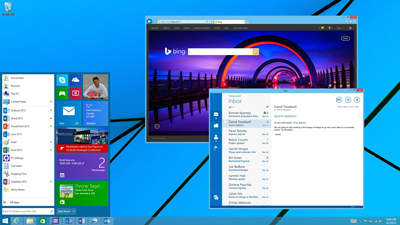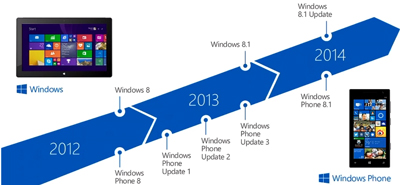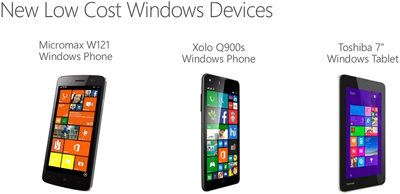News
Microsoft Talks Up Recent Windows Updates, Stays Quiet on 'Threshold'
- By Kurt Mackie
- July 17, 2014
Microsoft spent much of Wednesday's Worldwide Partner Conference (WPC) keynote touting recent improvements to Windows and Windows Phone, but gave few details about its plan for the platforms going forward.
Tony Prophet, corporate vice president of Windows Marketing for the Worldwide Partner Channel, gave a discussion about OS improvements during Wednesday's talk. Prophet, who recently came to Microsoft via Hewlett-Packard, said that Microsoft had "nothing to announce today" about the next Windows release. Instead, Prophet showed the same mockup of the new Start Menu that Microsoft had displayed at its Build developer conference back in April.
 [Click on image for larger view.]
Start screen mock-up shown at Microsoft's Build developer event. Source: Microsoft.
[Click on image for larger view.]
Start screen mock-up shown at Microsoft's Build developer event. Source: Microsoft.
Prophet said that the new Start Menu will show Live Tiles and Windows Store Apps in its display, as illustrated in the Start Menu mockup. Microsoft is also considering enabling Windows Store Apps to run in their own sizeable windows on the Desktop side of the OS, rather than just full screened on the Windows Store Apps (also known as "Metro") side, in the next Windows release. Those descriptions broke no new ground. For instance, a Microsoft official had suggested back in April that Windows Store Apps would be designed to "run in a window."
Microsoft has not disclosed when the next Windows OS will arrive, although Kevin Turner, Microsoft's chief operating officer, did describe it by its "Threshold" code name in another WPC talk, confirming the name that had been leaked earlier by veteran Microsoft reporter Mary Jo Foley. The Threshold OS release is expected to arrive in the spring of 2015, according to a report by Foley, citing unnamed sources. Supposedly, Threshold will have different product formulations, according to Foley's account, and it will support Windows Store Apps and/or Desktop sides of the OS, depending on the device type.
While Threshold is expected to arrive next year, a second Windows 8.1 Update is planned for release this year, sometime in August, Foley has said. Microsoft's first Windows 8.1 Update got released in April. It added various keyboard and mouse enhancements.
Windows 8.1 Enhancements
Those keyboard and mouse enhancements for Windows 8.1 Update were demonstrated during Prophet's talk by Nick Hedderman, a global product marketing manager at Microsoft. The Windows Taskbar now displays both Desktop apps and Windows Store Apps. Windows Store Apps now have controls and "mini-pop-ups." Windows Store Apps can be closed and minimized using those controls. The Title Bar and Taskbar become visible on the Windows Store Apps side of the OS when hovering the mouse cursor at the top and bottom of the screen, respectively. It's now possible to select multiple tiles using the control button.
Despite Windows use being 14 percent globally, it's still used by 1.5 billion users around the world, according to Prophet. He noted that Microsoft is "accelerating the pace of our innovation and roadmap." Microsoft is working with its hardware partners to deliver lower-cost devices, he added. Earlier this week, Kevin Turner, Microsoft's chief operating officer, provided examples of that pricing to come, from $99 tablets to $199 laptops, which are expected to arrive this holiday season.
 [Click on image for larger view.]
Windows 8 and Windows Phone 8 release cycle. (Source: Microsoft Worldwide Partner Conference keynote, July 16, 2014.)
[Click on image for larger view.]
Windows 8 and Windows Phone 8 release cycle. (Source: Microsoft Worldwide Partner Conference keynote, July 16, 2014.)
Prophet said that the upcoming devices would have "as little as 1 gigabyte of RAM and 16 gigabytes of storage." He also noted that Microsoft added "64-bit Windows support to the Intel Atom architecture." Toshiba is working with Intel on an entry-level Windows tablet with a 7-inch screen that "will be available soon" at a price competitive with seven-inch Android devices, he said. Prophet contended that the new Windows devices would cost less than currently available iPhones and iPads.
In May, Microsoft had announced a new Windows 8.1 with Bing edition for OEMs, in which tablets and PCs come preconfigured with Microsoft's search service. It wasn't specifically mentioned during this WPC talk, but this is a royalty-free version of the OS for small tablets. It's expected to arrive this fall.
Prophet said that Apple iPads lack the peripheral support of "SD cards, USB ports and native pen support" found in Windows systems. He added that Windows devices work offline, contrasting that capability with the more Internet-dependent Google Chromebooks.
Microsoft is facilitating Windows on different device form factors with its universal apps OS platform concept, according to Prophet. The idea is to make it easier for application developers to port their code across PCs, tablets and smartphones. Prophet said that this approach will help developers "create universal apps that run across Windows devices, from a 4-and-half-inch smartphone up to an 82-inch Windows PPI display." Application support for high pixel densities on Windows 8.1 apparently has been a bumpy ride so far, though, at least according to one report.
Prophet said that the Windows app catalog currently contains "hundreds of thousands of apps." He noted some current line-of-business apps, such as SAP mobile apps for Windows and Windows Phone. Salesforce1 will be coming to Windows and Windows Phone this fall, he said.
Windows Phone 8.1 Enhancements
Prophet outlined Windows Phone efforts, too. Microsoft provided smartphone reference designs to Qualcomm to speed up the introduction of low-cost smartphones, he said. OEMs making devices with displays of less than 9 inches don't pay Windows Phone royalties. The low-cost Micromax Windows Phone device will be available later this month with a 5-inch HD display, a dual SIM and a Qualcomm Snapdragon Quad 4 processor. The Xolo Windows Phone will arrive this month in India with a 4.7-inch display and dual SIM, he added.
 A few low-cost Windows devices. (Source: Microsoft Worldwide Partner Conference keynote, July 16, 2014.)
A few low-cost Windows devices. (Source: Microsoft Worldwide Partner Conference keynote, July 16, 2014.)
Microsoft has made changes to the Windows Phone Start Screen, adding an Action Center that shows notifications. The keyboard has a "shape writing" feature when composing messages that completes words. Microsoft added the Cortana personal assistant to Windows Phone. Cortana is available in the United States, with rollouts to the United Kingdom and China planned for later this year, according to Hedderman. Cortana correctly predicted 15 of 16 rounds of the World Cup, beating Google, he added. He showed that Cortana can schedule alarms and appointments and will warn if there are any conflicts. Cortana can work with other applications, too, including a Sage enterprise resource planning app to deliver warehouse stock information to an end user.
The new enterprise features in Windows Phone include virtual private network support, Wi-Fi, certificate management and S/MIME for encrypted e-mail. Hedderman showed how personal files stored on Microsoft's OneDrive cloud-based storage service could be mingled with files from corporate e-mail on a Windows Phone device. The user can then un-enroll their personal device, if wanted. When that's done, the corporate-owned applications and data get removed from the device.
More from WPC 2014: